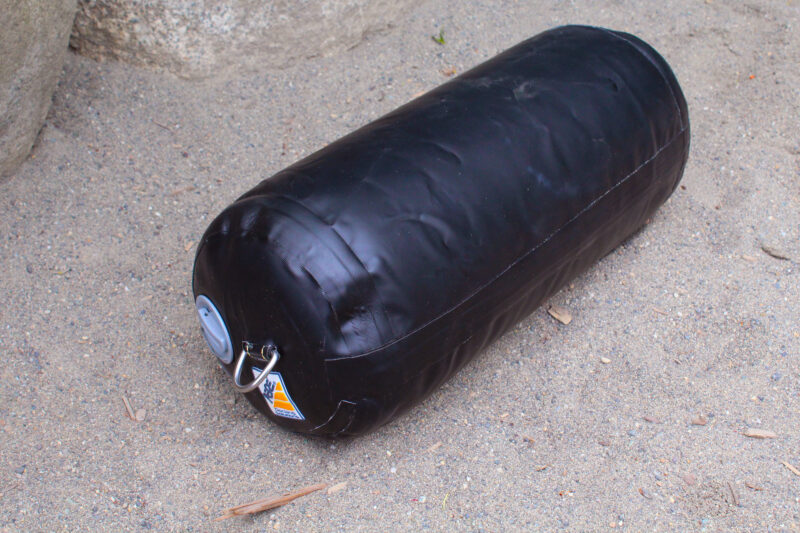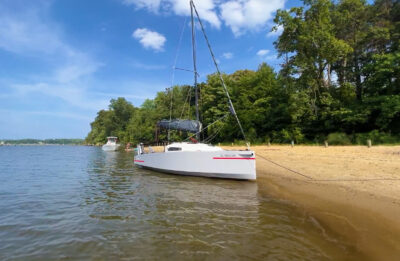Aeré makes an inflatable beach roller that works wonderfully well on all kinds of beaches from sand to shingle, but at 5′ long they’re much larger than I need for my canoes and kayaks, the boats I normally pull ashore. The Florida-based company also makes a wide variety of inflatable fenders that are built in the same manner as the rollers. Their core of heavy polyester fabric is coated with a thick layer of PVC inside and out. The seams are welded and reinforced with strips of additional material, glued in place.
 Photographs by the author
Photographs by the authorThe Aeré fender’s sturdy construction and tough material enables it to double as a roller for small boats.
The smallest Aeré fender measures 9″ in diameter and is 22″ long, a very good size for my canoes and kayaks. It has the same spring-equipped valve as the roller and a stainless-steel D-ring on each end. Aeré rates the roller’s capacity as 2,000 lbs but doesn’t offer a figure for the fender. I measured the thickness of the material of the fender and the roller by pinching a fold flat between the jaws of a caliper. The material is compressible, and the results varied, but the fender material seemed to be about 90% as thick as that used for the roller and presumably would have 90% of the strength. While the numbers for the fender work out to a capacity of 1,800 lbs, that’s far more than I’d ever subject it to. I put a load of 345 lbs on the fender and it was unaffected.

A pressure of just 1 psi is all that’s required to ready the fender for use. According to the manufacturer, the fender will feel “like a soft grapefruit” when properly inflated.
My 18′ 9″ lapstrake tandem canoe weighs about 80 lbs and has a beam of 30″. The Aeré fender works well for moving it across a beach that has bands of shingle, wet sand, and dry sand. The fender isn’t inflated to a high pressure—while Aeré tests its fenders to 45 psi, their standard operating pressure is just 1 psi. That low pressure allows the fender to mold itself to the hull it’s supporting and to flatten against the ground to smooth the ride over rocks and keep it from sinking into soft, dry sand. There is none of the friction caused by one surface sliding across another, so the fender should last a long time and protect hulls from damage caused by dragging them ashore.

Each end of the fender has a stainless-steel D-ring as an attachment point. The valve is a Halkey-Roberts type.
Of course, the Aeré fender will also serve its intended purpose admirably. With a D-ring securely attached to each end, it can be hung vertically or horizontally. Its usefulness doesn’t end there. It can serve as a buoy if one is needed, and in camp it can make a very comfortable seat. My knees no longer fold well enough to sit on it, fully inflated, on flat ground, so I prefer to set it on a log or a rock for a bit of height. I can partially deflate it to provide a softer, broader surface. With more air let out, the ends of the fender curl around and make contact with my hips, a feature that will come in handy if I need a change of seat in my canoe with something that will keep me held on the centerline. With the fender partially deflated and covered with a fleece jacket, it’s an exceptionally nice pillow. I sleep on my side, and I can adjust the fender to get my neck straight and neutral.

Deflated, the fender is compact and easy to stow.
Fully deflated, the fender is easily packed and doesn’t take up much space. The key to getting the most use out of it is to have a way to inflate it quickly and easily. The standard manually operated piston pumps used for inflatable devices are bulky and would take up more space than the deflated fender, so they’re not a compatible option. Compact rechargeable air pumps can do the job if you happen to have one, but there’s no need to go to the expense of buying one if you don’t. I tried just blowing into the fender’s valve, but that didn’t work. The fender’s valve is spring-loaded, and I can’t generate enough pressure to get air past it. To make an oral inflation device, all I needed was a short piece of plastic pipe, a bit of dowel, and some tape.

The fender is normally inflated with a low-pressure pump, but with a simple homemade device it can be inflated orally.
I took a piece of PVC 1⁄2″ schedule 40 pipe—standard water pipe that is available at almost any hardware store—and drilled a 1⁄4″ hole through it about 3⁄4″ from one end. I tapped a piece of 1⁄4″ dowel into the holes and cut the ends flush. The pipe is a slightly loose fit in the fender’s valve, so I wrapped a few turns of plastic electrician’s tape around the end of the pipe, starting high to cover the ends of the dowel and finishing with three or four turns around the end.
To inflate the fender, I press the taped end into the valve. The dowel depresses the spring-loaded stopper so I can blow on the other end of the pipe and the air will pass freely into the fender. It can flow freely out too, so between breaths I let the valve press the pipe out.

The dowel inside the inflation device depresses the fender’s valve stem to allow the easy passage of air.
I wasn’t able to measure how much pressure I could generate to inflating the fender orally, as my tire gauges didn’t register even my strongest effort. On the web I found that we average humans can generate 1 psi to 2 psi, which is right on target for the fender.
There’s no need to fully inflate the fender orally and get light-headed in the bargain. I hook an index finger in each of the D-rings and press the valve with my thumb. As I pull my hands apart, air is drawn into the fender as if it were an accordion. I release the valve and then use the pipe to top it off with three breaths. It takes under 15 seconds. (I used the same trick on my Aeré roller. With its long sides, it didn’t pull in quite so much air, but it took only 20 breaths to fill it to normal pressure.)
The 9 × 22 fender from Aeré serves so many purposes, it would be difficult to come up with an excuse not to take it aboard any of my boats.![]()
Christopher Cunningham is the editor of Small Boats.
The 9 x 22 Fender from Aeré costs $72.95 when ordered direct from Aeré. I bought mine from Fisheries Supply in Seattle for $77.83.
Is there a product that might be useful for boatbuilding, cruising, or shore-side camping that you’d like us to review? Please email your suggestions.












Thanks for the tip on the inflator. I didn’t have 1/4” dowel on hand but saw my glue gun and used part of a stick. The device works well but I was concerned about losing it so I looped a lanyard around it and sealed it to the PVC with some hot glue. As you noted, I inflated the roller in less than 20 puffs. Now I don’t have to carry the bulky pump on my dory!